History of Chelyabinsk
Foundation of Chelyabinsk
In 1736, the fortress named Chelyaba (most likely, a Bashkir word) was founded on the Miass River. One of the reasons for the construction of this and several other fortresses located nearby was the threat of attacks of the Bashkirs on caravans with supplies. The fortress became part of the Ufa Province.
In 1748, the first stone church was laid in the fortress. In 1781, it received the status of a town called Chelyabinsk. In 1782, the coat of arms of Chelyabinsk was approved by decree of Empress Catherine II. A loaded camel depicted on it meant that trade routes passed through this town located in the Asian part of the Russian Empire. In 1795, the population of Chelyabinsk was about 2,700 people.
By the middle of the 19th century, this town played an important role in trading in the Urals. Until the end of the 19th century, Chelyabinsk remained a small town. In 1882, its population was about 7,700 people. The second birth of Chelyabinsk took place in 1892 - after the completion of the construction of the Samara-Zlatoust Railway, which connected Chelyabinsk with the European part of the Russian Empire.
After 1892, the construction of the Trans-Siberian Railway continued further to the east of the country. In 1896, the further development of Chelyabinsk was facilitated by the commissioning of the branch of the Ural Mining Railway, which connected Chelyabinsk with Yekaterinburg. In just a few years, the town became one of the leaders in bread, butter, meat, and tea trade in the Russian Empire. Chelyabinsk was unofficially called “The Gateway to Siberia”.
More historical facts…
Chelyabinsk in the first half of the 20th century
In just a decade, the population of the town grew significantly (in 1897 - about 20 thousand people, in 1910 - more than 60 thousand), and the territory increased by one third. For rapid growth at the turn of the 19th and 20th centuries, similar to American cities, Chelyabinsk was sometimes called “Chicago beyond the Urals”.
The armed rebellion of the Czechoslovak Corps after the events at the Chelyabinsk Railway Station on May 14, 1918 and the capture of the city on the night of May 26 to 27, 1918, led to its participation in the Civil War in Russia on the side of the Committee of Members of the Constituent Assembly and later on the side of A. V. Kolchak (one of the leaders of the White Armies opposing the Reds (Bolsheviks)). In July 1919, the Reds occupied Chelyabinsk and Bolshevik authorities began to form in the city. In 1923, the population of Chelyabinsk was about 54,300 people.
On September 3, 1919, Chelyabinsk became the center of the Chelyabinsk province. On November 3, 1924, it was transformed into the Chelyabinsk district of Ural Oblast. On January 17, 1934, Ural Oblast was divided into three separate regions - Sverdlovsk Oblast with a center in Sverdlovsk, Chelyabinsk Oblast with a center in Chelyabinsk, and Ob-Irtysh Oblast with a center in Tyumen.
In 1937, there were discussions about renaming the city of Chelyabinsk in Kaganovichgrad in honor of Lazar Kaganovich, a Soviet politician and administrator. During the first Soviet five-year plans, Chelyabinsk became one of the largest industrial centers of the USSR. From the beginning of the 1930s, tractor, abrasive, ferroalloy, electrode, machine tool, and zinc plants began to operate. In 1939, the population of Chelyabinsk was about 273,000 people.
Chelyabinsk during the Second World War
During the Second World War, Chelyabinsk played a very important role as a production base. The population of the city grew rapidly from 270 to 650 thousand people. On the basis of more than 200 enterprises evacuated from the western regions of the USSR that merged with local industries, several giant plants were opened: the Chelyabinsk Forge and Press Plant, the Chelyabinsk Metallurgical Plant, and the Chelyabinsk Pipe Rolling Plant.
After combining the capacities of the Chelyabinsk Tractor Plant with two evacuated enterprises - the Leningrad Kirov Plant and Kharkov Engine-Building Plant, mass production of tanks (KV-1, IS-2, T-34) and self-propelled guns (SU-152 and ISU-152) began. In total, during the war, about 60 thousand tank diesels and 18 thousand fighting vehicles (20% of all Soviet fighting vehicles) were produced in Chelyabinsk. By the end of the war, every third Soviet tank and combat aircraft had Chelyabinsk steel. The city acquired a new unofficial name - Tankograd (The City of Tanks).
During the war years, about 220,000 people were sent from the front to Chelyabinsk for treatment, 78% of them returned to service after healing their wounds. In 1941-1944, the Kiev Medical Institute, evacuated from the capital of Ukraine, was training medical doctors in Chelyabinsk. In 1944, the Chelyabinsk Medical Institute was established on its basis.
Chelyabinsk in the second half of the 20th century and beyond
In the post-war period, Chelyabinsk became a supplier of equipment, machinery, and specialists for the reconstruction of Stalingrad, Donbass, DneproGES, and other industrial centers. In 1947, a new development plan was approved, which provided for multi-storey buildings in the city center and areas adjacent to industrial enterprises. This radically changed the panorama of Chelyabinsk.
By 1960, there were already about 15 thousand students in Chelyabinsk. In 1976, Chelyabinsk State University was founded - the first classical university in the South Urals. By the 1980s, the capital of the South Urals became a major scientific center of the USSR with 7 universities and about 40 research and design institutes.
On October 13, 1976, a millionth resident was born in Chelyabinsk. By 1980, its enterprises produced more than 50% of Soviet stainless steel, 20% of pipes, 30% of ferroalloys. At this time, the new building of the Chelyabinsk Drama Theater with 1,200 seats was opened, the Chelyabinsk Puppet Theater gained all-Russian fame. In 1986, Chelyabinsk celebrated its 250th anniversary. In honor of this, a geological museum, a chamber and organ music hall were opened.
The first half of the 1990s, after the collapse of the USSR and the transition to a market economy, was a difficult time for Chelyabinsk and its huge plants. From the second half of the 1990s, industry gradually resumed production, and a lot of plants entered the world market.
In 2004, the pedestrian street of Kirovka was opened. It has become a favorite place for walks of Chelyabinsk residents and guests of the city. In 2006, the new building of the State Historical Museum of the South Urals was opened. In 2009, the ice arena “Tractor” with a capacity of 7,500 spectators was built. In the 2010s, after the recession of the 1990s, construction and commissioning of new housing intensified.
On February 15, 2013, a large meteor with a diameter of about 17 meters and a mass of about 10 thousand tons entered the atmosphere in the vicinity of Chelyabinsk (the Chelyabinsk Meteor). Fortunately, it exploded in the sky relatively high above the city. However, 7,320 buildings were damaged and 1,613 people were wounded as a result. Its debris fell into Lake Chebarkul, from where the largest fragment was later raised and delivered to the Chelyabinsk Museum of Local Lore.
Chelyabinsk views
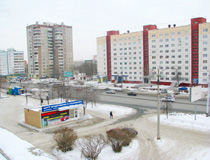
Winter in a residential area in Chelyabinsk
Author: Andrey Kalachev
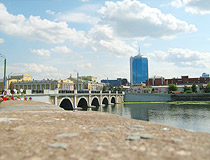
Trinity Bridge in the center of Chelyabinsk
Author: Angelina Galimzyanova
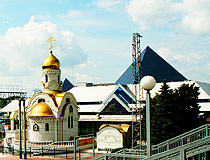
Church of the Smolensk Icon of the Virgin near the Chelyabinsk Railway Station
Author: Aleksey Podbelsky
Chelyabinsk - Features
Chelyabinsk, one of the ten largest cities in Russia, is located almost in the center of the continent of Eurasia (about 1,400 km from its geographical center), east of the Ural Mountains, 216 km south of Yekaterinburg.
This city is located on the border of the Urals and Siberia. That is why it is also informally known as “The Gateway to Siberia”. At the turn of the 19th and 20th centuries, after the construction of the Trans-Siberian Railway, a lot of travelers bought postcards at the railway station of Chelyabinsk and sent them around the world as evidence of their stay in Siberia. Leningrad Bridge connects the Ural and Siberian banks of the Miass River, thus it is a bridge from the Urals to Siberia.
On the coat of arms of Chelyabinsk you can see a loaded camel, as a sign that important trade routes passed through it, and a fortress wall showing that Chelyabinsk was founded as a fortress.
The climate of Chelyabinsk is temperate continental (transitional from temperate continental to sharply continental). Winters are long, moderately cold, and snowy. The average temperature in January is minus 14.1 degrees Celsius. Summers are moderately warm and dry. The average temperature in July is plus 19.3 degrees Celsius.
Due to the fact that Chelyabinsk is an industrial city with a large number of factories, the environmental situation in the city is poor. The level of air pollution is high. The city has an increased level for a number of diseases compared with the average for Russia.
Chelyabinsk is one of the largest industrial centers of Russia. The main industries are metallurgy, manufacture of finished metal products, engineering. Chelyabinsk Electrometallurgical Plant is the largest ferroalloy plant in Russia. Chelyabinsk Zinc Plant produces about 2% of the world and 60% of Russian zinc. Chelyabinsk Metallurgical Plant is the largest producer of stainless steel in Russia.
Through Chelyabinsk, traffic flows from the European part of Russia to Siberia. In particular, this city is the final point of the federal highways M5 Ural (Moscow - Chelyabinsk), R254 Irtysh (Baikal) (Chelyabinsk - Novosibirsk), A310 (Chelyabinsk - Kazakhstan). Public transport is represented by buses, trolleybuses, trams, and minibuses. The international airport “Chelyabinsk” offers flights to several large Russian cities, mainly to Moscow and St. Petersburg.
Chelyabinsk has historically developed as a center of several cultures: first of all, the cultures of the indigenous inhabitants of the region - the Bashkirs, Tatars, and Russians. There are Orthodox churches and mosques, a Catholic church, several Protestant churches, and a synagogue in the city.
Main Attractions of Chelyabinsk
Kirovka Pedestrian Street - an analogue of the pedestrian street of Arbat in Moscow. Here you can see a number of interesting monuments (“Zero Milestone”, the monuments to volunteer tankers, Alexander Rosenbaum, the founders of Chelyabinsk), as well as sculptures (“The Boy with the Camels”, “The Artist at the Mirror Easel”, “The Saxophonist”, “The Coquette”, “The Beggar”, “The Merchant”, and others).
Also on this street there are shops, cafes, entertainment facilities, buildings of the early 20th century, and the business center “Chelyabinsk-City”.
Aloye Pole (Scarlet Field) - a park located in the very center of Chelyabinsk, one of its most popular holiday destinations. In the 19th century, it was a square where the city fair was held. In 1905, a demonstration of workers was dispersed by force here. That’s why the place got a new name - “Scarlet Square”. In 2000, the park received the status of a historical place.
Central Park of Culture and Rest named after Yury Gagarin. This park adjacent to the relict pine forest is the most beautiful park in Chelyabinsk with rides, sports grounds and playgrounds, a contact zoo, a summer movie theater. Fresh air, thick crowns of trees, blue expanse of ponds, comfort, and cleanliness attract residents and visitors of the city.
Chelyabinsk Zoo. On an area of 8 hectares, more than 130 species of animals live, of which more than 80 are listed in the Red Book including polar bears, Amur tigers, leopards. There is also a contact zoo on the territory, where children can also feed animals and play with them. Truda Street, 191.
Historical Museum of the Southern Urals. There are three permanent exhibitions dedicated to nature and ancient history, folklife, and history of the 20th century. The museum has old photographs, documents, books, paintings of the 18th-20th centuries, household items and clothing of Russians, nomads, and Tatar-Bashkir tribes, Zlatoust engravings, ancient coins, mineralogical collections, bones of extinct animals, and stuffed animals.
The museum also exhibits the largest (weighing half a ton) of the found fragments of the Chelyabinsk Meteor that exploded in the sky above the city at an altitude of about 15-25 km in 2013. Truda Street, 100.
Museum of Fine Arts. This museum has several thousand exhibits of Western European, Eastern, and Russian art. Here you can see the works of world-famous artists: Aivazovsky, Levitan, Shishkin. Also there is an interesting collection of icons of the 16th-19th centuries. Truda Street, 92a.
Museum of Arts and Crafts of the Urals. Here you can see the whole range of folk art crafts of the Southern Urals: products of the Zlatoust weapons factory, exhibits demonstrating the skill of local carvers and jewelers, hand-painted utensils, porcelain products of the South Ural factory, etc. Revolution Square, 1.
Chelyabinsk Railway Museum. The museum exposition is located in two places: in the building #63 on Tsvillinga Street, where more than 14 thousand exhibits are stored, and at the Chelyabinsk Railway Station (Zheleznodorozhnaya Street, 1/1), where you can see various railway equipment: steam locomotives, electric locomotives, modern trains, military trains, and special equipment. In the exhibition halls, you can see rails, station bells, old tickets, lights, signaling devices, and other items.
Museum of the Chelyabinsk Tractor Plant - the largest and most popular museum in the region. It is dedicated to the history and activities of the Chelyabinsk Tractor Plant. The museum has several thousand photographs, documents, personal belongings of employees, posters, newspaper clippings. It is better to visit this museum with a thematic tour, during which you can not only learn interesting facts, but also feel the true spirit of the plant and the city of Chelyabinsk. Lenina Avenue, 19.
Holy Trinity Church (1914) - the largest church in Chelyabinsk built of red brick and topped with a green roof. The main feature of this building is a large number of arched windows on all tiers and an abundance of decorative ornaments on the facade. Inside, the walls and ceiling are painted with murals on biblical themes. Kirova, 60?.
Monument to Kurchatov. Igor Kurchatov, the famous Soviet scientist and creator of the first atomic bomb in the USSR, was born in the town of Sim of Chelyabinsk Oblast in 1903. In 1986, in honor of the 250th anniversary of Chelyabinsk, the monument “Split Atom” was erected in his honor on Nauki (Science) Square. It consists of two vertical platforms 27 meters high, which symbolize an elementary particle, and the figure of Kurchatov standing in the middle. Lenina Avenue, 86.


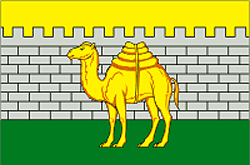
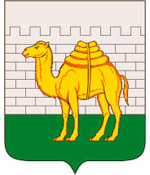
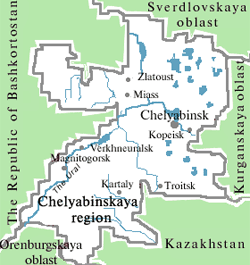



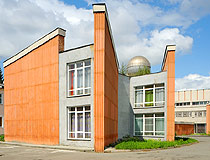
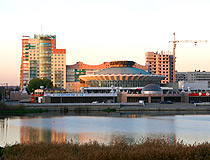
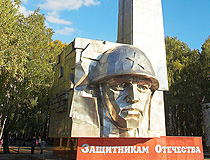
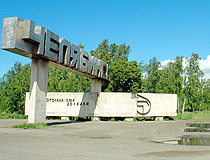
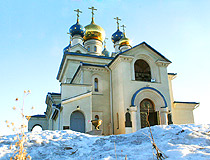
The comments of our visitors